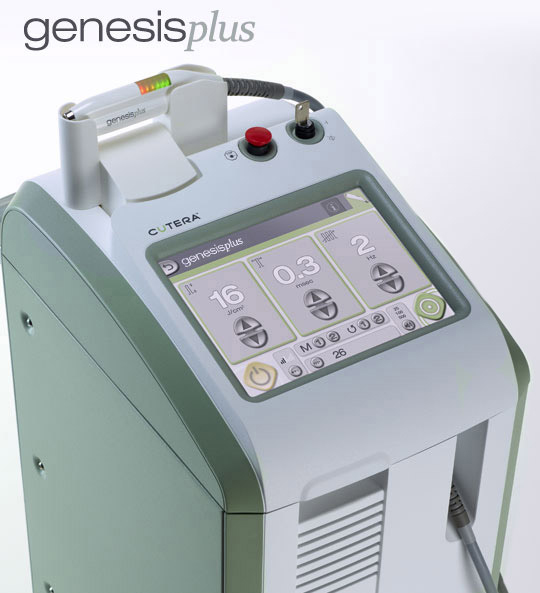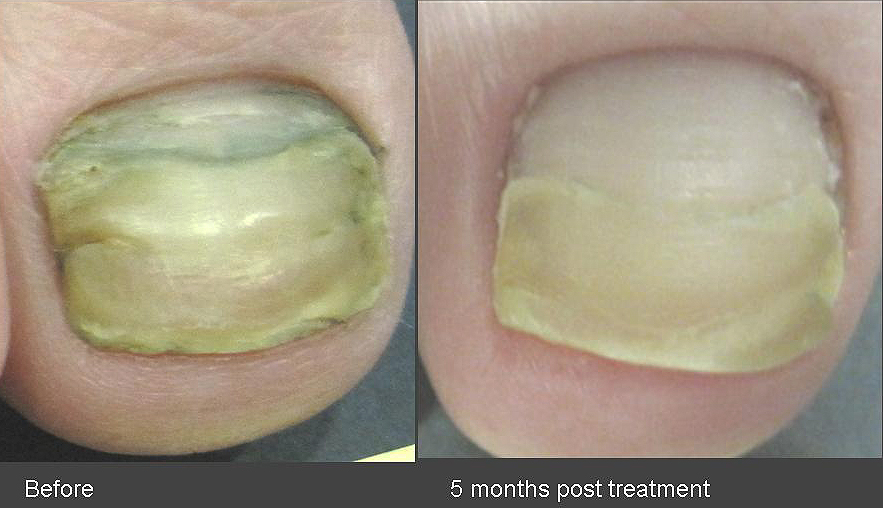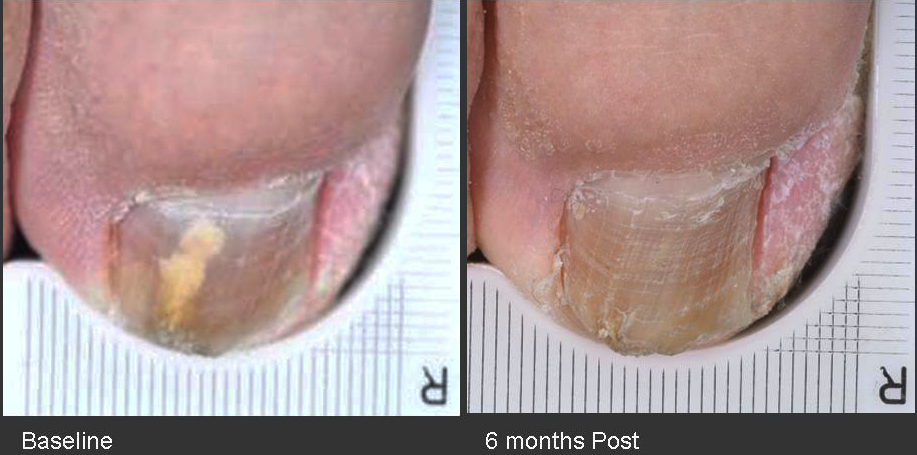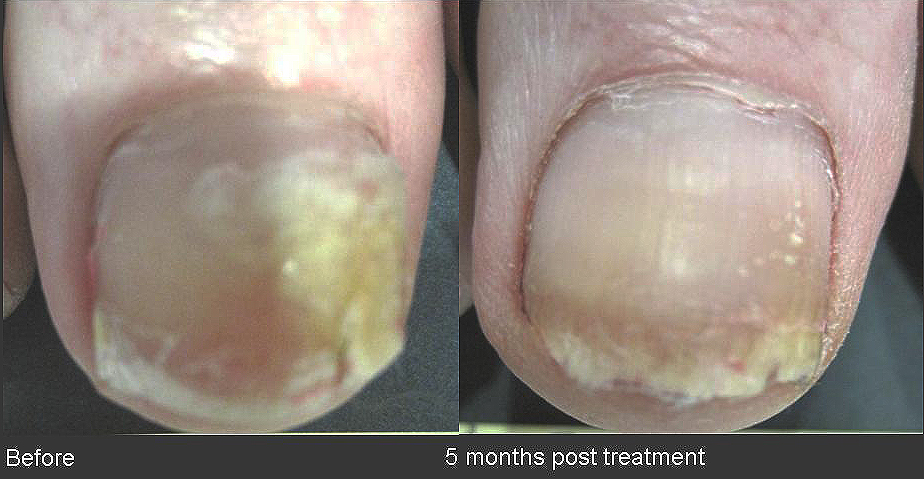Cutera GenesisPlus Laser
Toenail fungus can be a thing of the past for you, thanks to the innovative Cutera GenesisPlus Laser, which has an amazingly high cure rate of 60%! Topical medications are only 2-5% successful and take a year of treatment. Oral medications, which are 60% successful, have to be taken for three months and can adversely affect the liver. The Cutera GenesisPlus laser has little to no side effects.



Treatment of Fungus Toenails
Milton J. Stern, DPM FACFAS
First thing you need to know:
Not every toenail that looks fungused has fungus in it. There are many things that make a nail look like it is infected. As we get older the nail can naturally thicken. Other factors such as metabolic change and the reduction of blood flow also play a role. A few diseases such as psoriasis and lichen planus can cause nails to get wavy, flaky and thick. Infections like Pseudomonas can deform nails and discolor them green. Molds and spores can infect the nail. Systemic diseases such as psoriasis, eczema, rheumatoid arthritis, cardiovascular disease, and cancer, to name a few, may affect the toenails. One of the most common causes of thick toenails and has nothing to do with infection or systemic diseases but is caused by trauma including micro trauma. This condition is called dystrophy and there is no current way of treating this correctively but only accommodatively. The only true way to determine if the nail has fungus in it is to do a fungus culture on the nail. The nail fungus culture is very expensive and the first test that is performed is a PAS (Periodic Acid-Schiff) and if this is negative a GMS (Gomori Methenamine Silver) is performed. These run between $250 and $500. Even if this fungus culture comes back positive for fungus, the fungus itself might have caused dystrophy to the nail and treatment with either medication or laser or a combination of these might give someone mycological cure from the fungus but the nail still might remain deformed.
What are your options?
We are now making the assumption that the nail is indeed infected with a fungus or no nail fungus culture was performed and there is a desire to treat the nail anyways. Most people by the time they see us have tried other modalities which have failed and a look at this and being a last resort. Many of the people that we see are very severely fungus with thick and discolored nails. Those people to treat the fungus in the earlier stages have a much better success rate.
1: Option 1 is to do no treatments and live with the condition knowing that slowly it will get progressively worse.
2: Option 2 is to try and treat the nail topically. This has anywhere from 2-7% success rate. This treatment is more successful when only a small piece of distal nail has an infection. There are many topical medications that are prescription. There are also many homeopathic treatments such as Tea Tree Oil and Vicks VapoRub. We usually recommend a 1-2 times daily treatment. We recommend mixing any of the medications with urea. This is a keratolytic and makes the medication more penetratable into the nail. We also suggest that one files the nails thinner especially over the area that might be infected once a week. We also recommend everyone to take Biotin which is a vitamin B supplement which is good for hair and nails.
3: Option 3 is to temporarily avulse the toenails. This is done after anesthesia is applied. The nail plate is removed. The nail is allowed to grow back which can take 7-9 months. Toenails grow at a 0.1 mm per day. While the nail is not on the nail plate and nail plate can be treated topically, orally or with laser. Depending on how aggressive the treatment is the success rates can run anywhere from 3-50%.
4: Option 4 is to permanently remove the toenails. Anesthesia is applied to the nail and once the nail is avulsed either phenol or sodium hydroxide is used to cauterize the matrix. 90% of the time no toenail will re grow and the fungus will be gone.
5: Option 5 utilizes oral medication. The 2 medications that we use our practice are Lamisil and Sporanox. Both these medications are taken over 90 day period. Lamisil is taken once a day for 90 days. Sporanox is pulsed dose so one takes 2 pills twice a day for 7 days. Patient does not take any medication for 21 days. Patient then repeats the weekly taken of the medication 2 more times. Both indications have an approximately 60% success rate. If a fungus culture is performed prior to treatment and it is positive the success rate goes to 70%. Both these medications are excreted by the liver and can raise liver enzymes. Prior to any treatment we will check the liver enzymes and then repeat the test in 6 weeks. These medications have a few other side effects which include possible allergic reaction, taste disturbances and of course elevation of liver enzymes. There is literature out there that states that Lamisil can be 90% effective if only taken for 1 week and then not taking any medication for 3 weeks. This is repeated for up to 4-6 months. This means the total amount of medication taken over 6 months is less than half of what it would’ve been over 90 days. We know that the nail takes 7-9 months to regrow so there is current treatment during the whole growing phase of the nail.
6: Option 6 is the use of a laser light to kill the fungus underneath the nail. We use the Cutera GenesisPlus laser. The system applies laser energy to the toenail plate and surrounding tissue including the matrix of the nail which is the growth center. The laser light gradually heats the fungus and promotes the growth of healthy, clear nails. Just like the oral medication the success rate is approximately 60%. Again if there is a positive nail fungus culture the success rate goes to 70%. Normally it is recommended that 2 treatments are used 6 weeks to 2 months apart. In our practice we usually give 3 treatments 2 months apart. As with any of the prior options we recommend taking biotin, treating the nails topically with an antifungal mixed with urea and once a week filing of the nails.
7: Option 7 is really a combination of prior options. It all depends on how aggressive one wants to treat their condition. It is recommended that if one undergoes laser and the nails do not clear that re treatment with laser while taking oral medication of Lamisil or Sporanox concurrently. The newest literature out there states that Lamisil can be pulsed so one only takes 1 pill a day for 7 days and then does not take the pill for 21 days. This means that over a six-month period the patient has only taken 42 pills instead of 90 pills over a three-month period. This will definitely reduce the adverse effects of the medication. To be really aggressive one can have the nails temporarily avulsed, take oral medication and treat the nail plate and matrix with laser.
© Copyright 2015 Podiatry Website Design
Cutera Laser in Southfield | 48034 Cutera Laser | Cutera GenesisPlus Laser 48034